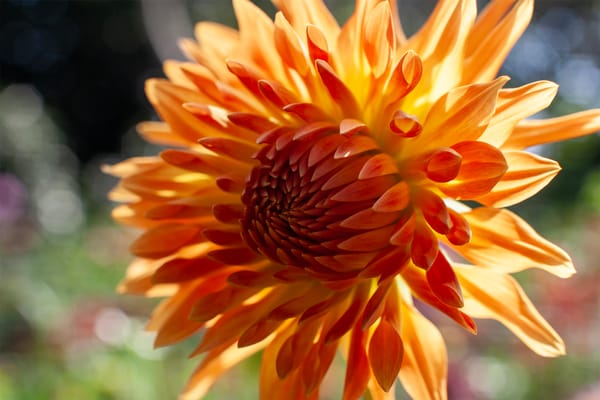Cornwall’s unique climate and richly varied soils offer both opportunity and challenge to the dahlia grower. In this region of shifting mists, mild winters, and lush, rain-fed landscapes, dahlias flourish — but only when the soil beneath them is thoughtfully prepared and attentively managed. For those with a working knowledge of dahlias, delving deeper into the intricate relationship between plant and soil can unlock a new level of success. This is the story of soil and dahlias in Cornwall: a practical journey from ground to glorious bloom.
The Character of Cornish Soil
Cornwall’s geology gifts its gardens with a patchwork of soil types. From light, sandy loams that drain freely, to heavy clay pockets that cling stubbornly to water, the diversity is remarkable. Yet most Cornish soils share a common trait — a natural acidity, often leaning towards the ideal pH range for dahlias: 6.5 to 7.0.
Loamy soils, rich in humus and crumbling between the fingers, offer the best start for dahlias. They hold moisture without becoming waterlogged and allow roots to breathe. On the other hand, sandy loams, common along Cornwall’s coastal fringes, benefit from the addition of organic matter to retain nutrients and moisture. Meanwhile, clay soils — prevalent in valley bottoms and older farmland — demand more intervention but can, with care, become fertile beds for dahlias.
Preparing the Ground: The Foundation of Dahlia Success
Organic Matter — The Lifeblood of Healthy Soil
At the heart of every flourishing dahlia bed is a foundation of rich organic matter. Well-rotted compost or aged farmyard manure improves structure, enhances moisture retention in lighter soils, and opens the dense texture of clay. In Cornwall, where autumn rains can leach nutrients, annual applications of organic matter replenish what is lost and support the vibrant microbial life essential to healthy roots.
Leafmould, often overlooked, brings slow-release benefits — enhancing soil texture and nurturing the living soil web. Similarly, composted bark and woody mulches help prevent the compaction common in wet Cornish winters. Used as surface dressings, they protect soil structure while slowly integrating into the top layers.
The Crucial Role of Drainage
Dahlias abhor wet feet. In Cornwall, where high rainfall is a given, ensuring excellent drainage is non-negotiable. For clay soils, this means liberal incorporation of coarse organic matter and horticultural grit. Raised beds offer a practical solution, lifting tubers above the soggy winter soil and allowing better root aeration.
Yet even well-structured soils benefit from careful planting. Positioning tubers on a slight mound within the planting hole encourages water to run away from vulnerable crowns. In heavier soils, starting tubers in pots allows roots to establish before transplanting into the garden once the risk of cold, wet shocks has passed.
The pH Puzzle: Fine-Tuning Your Soil Chemistry
Though most Cornish soils hover within the ideal range, it pays to know your soil’s precise pH. Dahlias thrive in slightly acidic to neutral conditions (6.5–7.0). Stray too far on either side and nutrient uptake falters — iron becomes less available in alkaline soils, while overly acidic conditions can inhibit key root functions.
For gardeners in older woodland gardens or areas with peat influence, liming may be necessary every few years. Conversely, in rare alkaline spots, incorporating elemental sulfur or organic materials like composted pine bark can gently nudge pH back into balance.
Regular soil testing — every two or three years — ensures you remain in the optimal zone, adjusting as needed without guesswork.
Planting Practices for the Cornish Grower
When the soil warms beyond 10°C in late spring, the planting window opens. In Cornwall, this generally falls between late April and early June. Planting too early, especially in colder inland areas, risks tuber rot or sluggish growth.
Position tubers horizontally, 15–20 cm deep, in prepared soil enriched with compost. Spacing — a generous 60–75 cm apart — allows airflow, reducing the risk of mildew in Cornwall’s humid summers.
Mulching after planting serves triple duty: conserving moisture, suppressing weeds, and gently feeding the soil as organic mulches break down. In coastal Cornish gardens, where winds whip across borders, early staking helps support rapid summer growth and prevents wind-rocking — a common cause of root disturbance.
The Seasonal Rhythm: Managing Dahlias and Soil Throughout the Year
Spring sees the groundwork laid — beds prepared, amendments dug in, and tubers planted once the danger of frost passes. Early summer is a time for pinching out growth tips, encouraging bushier plants and stronger stems. As dahlias surge towards flowering, a fortnightly liquid feed high in potassium supports abundant blooms.
Midsummer brings the joy of cutting, and with it, the need for attentive watering. In Cornwall’s typically moist climate, deep, infrequent watering encourages deeper roots — but vigilance is key in sandy soils prone to rapid drying.
Autumn marks both climax and closure. Deadheading prolongs the show until frost cuts the season short. Then comes the question every Cornish gardener must weigh: lift or leave? In well-drained, sheltered sites, mulching heavily over tubers may see them safely through winter. But where soil remains cold and wet, lifting and storing tubers in a frost-free shed is the safer route.
Soil Troubleshooting: Common Challenges in the Cornish Dahlia Patch
- Waterlogging and Rot: Yellowing leaves and stunted growth often signal waterlogged soil. Remedy by raising beds, improving drainage, and avoiding known wet spots.
- Acidic Soils Below pH 6.5: If plants are pale or stunted, test soil and lime accordingly — particularly after heavy rains.
- Nutrient Deficiency in Poor Soils: Regular organic amendments, combined with balanced feeding during the growing season, keep plants thriving.
The Dahlia Grower’s Arsenal: Organic Amendments for Cornish Gardens
- Well-Rotted Compost: The backbone of soil health, replenished annually.
- Aged Manure: Adds structure and fertility — ideal for heavy clay or sandy soils alike.
- Leafmould: Enhances water retention and soil structure.
- Composted Bark: Opens heavy soils and makes an excellent mulch.
- Peat-Free Compost: Sustainable and reliable for potting or soil improvement.
- Green Manures: Cover crops restore nutrients and prevent compaction in off-seasons.
- Worm Castings: Boosts microbial life and nutrient density.
- Bokashi: Fermented organic matter for soil vitality.
- Seaweed Extracts: Rich in trace elements — a tradition in Cornish coastal gardening.
- Rock Dust: Re-mineralizes tired soils.
Conclusion — A Partnership with the Land
Mastering soil for dahlias in Cornwall is less about rigid rules and more about forming a partnership with the land. It means reading your soil like a living text — understanding its needs, respecting its rhythms, and responding with care. For even the most experienced growers, the nuances of drainage, pH balance, and organic vitality offer endless opportunities to refine practice and deepen connection.
In this fertile, windswept corner of Britain, dahlias reward the attentive gardener with unrivalled beauty — blooms born not just of sun and rain, but of soil shaped by thoughtful hands and an intimate understanding of place.











